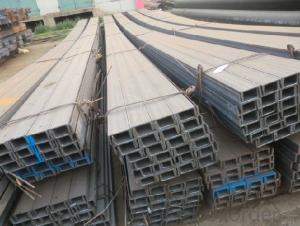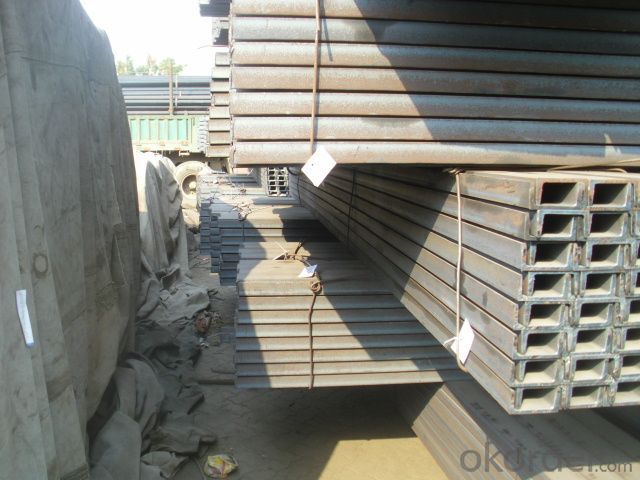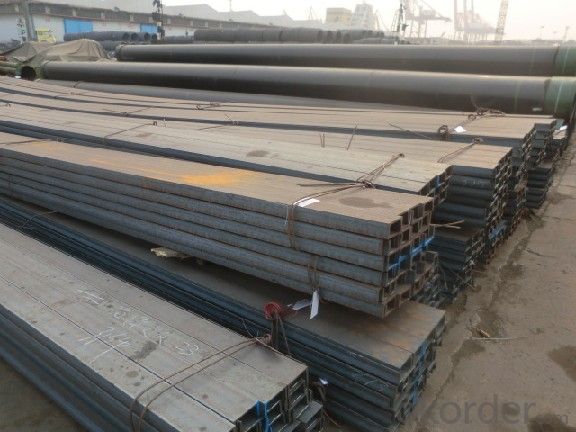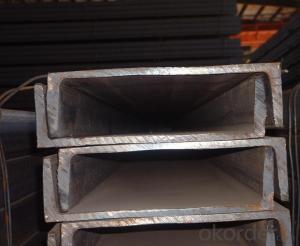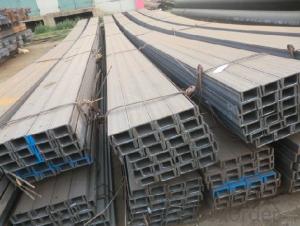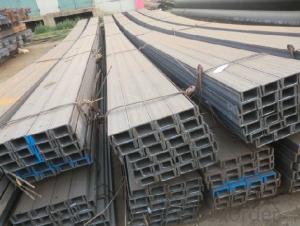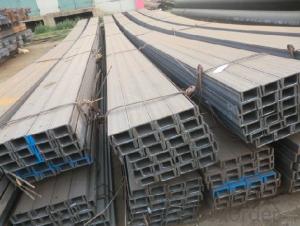hot channei and gb
- Loading Port:
- China Main Port
- Payment Terms:
- TT OR LC
- Min Order Qty:
- -
- Supply Capability:
- -
OKorder Service Pledge
OKorder Financial Service
You Might Also Like
| | | | | | |
| | | | | | |
Product Description:
1.We are able to provide channel steel of top quality at attractive price.
2.Our products of channel steel have passed ISO9001:2008 Quality Management System Certification.
3. The section of JIS Standard Channel Steel are as followings in the table.
| JIS U CHANNEL | Standard h | Sectional b | Dimension s | t | Mass: Kg/m |
| (mm) | (mm) | (mm) | (mm) | ||
| 50x25 | 50 | 25 | 3.0 | 6.00 | 2.37 |
| 75X40 | 75 | 40 | 3.8 | 7.00 | 5.30 |
| 75X40 | 75 | 40 | 4.0 | 7.00 | 5.60 |
| 75X40 | 75 | 40 | 4.5 | 7.00 | 5.85 |
| 75X40 | 75 | 40 | 5.0 | 7.00 | 6.92 |
| 100X50 | 100 | 50 | 3.8 | 6.00 | 7.30 |
| 100X50 | 100 | 50 | 4.2 | 6.00 | 8.03 |
| 100X50 | 100 | 50 | 4.5 | 7.50 | 8.97 |
| 100X50 | 100 | 50 | 5.0 | 7.50 | 9.36 |
| 125X65 | 125 | 65 | 5.2 | 6.80 | 11.66 |
| 125X65 | 125 | 65 | 5.3 | 6.80 | 12.17 |
| 125X65 | 125 | 65 | 5.5 | 8.00 | 12.91 |
| 125X65 | 125 | 65 | 6.0 | 8.00 | 13.40 |
| 150x75 | 150 | 75 | 5.5 | 7.30 | 14.66 |
| 150x75 | 150 | 75 | 5.7 | 10.00 | 16.71 |
| 150x75 | 150 | 75 | 6.0 | 10.00 | 17.90 |
| 150x75 | 150 | 75 | 6.5 | 10.00 | 18.60 |
4. Chemical Compostion of JIS Standard Channel Steel
| Grade | Element(%) | |||
| C | Mn | P | S | |
| SS330 | -- | -- | ≦0.050 | ≦0.050 |
| SS400 | ||||
| SS490 | ||||
| SS540 | ≦0.30 | ≦1.60 | ≦0.040 | ≦0.040 |
Usage/Applications of Channel Steel:
Channel Steel is usually used for building structure, vehicle manufacturing and other industrial structure and often used with i beam.
In details, the channel steel belongs to carbon structural steel which is applied to in the field of construction and machinery. The channel steel is usually used for arch-itechtural structure, and they could be welded in order to support or hang a vari-ety of facilities. They are also usually used in combination with I beam. Generally,the channel steel must possess perfect welding property, riveting property and mechanical property and so on.
Package & Delivery of Channel Steel:
The steel u channel will be packed in bundle with steel wire at each end of every bundle and color marking in order to help the customer to recognize his goods more easily at sight.
And steel u channel could be loaded into 20ft or 40ft container, or by bulk cargo. If the weight of each bundle reaches less than 3.5 mt, the loading by break bulk cargo should be choosed. When the weight of each bundle reaches less than 3mt, the loading by container should be choosed.
- Q: Can steel channels be used for HVAC ductwork?
- Yes, steel channels can be used for HVAC ductwork. Steel channels are commonly used in HVAC systems due to their strength, durability, and ability to withstand high temperatures. They provide structural support and ensure proper airflow in ductwork systems.
- Q: What are the considerations for steel channel connections to timber structures?
- There are several important factors to consider when connecting steel channels to timber structures. These factors include the compatibility of materials, load capacity, joint design, and potential for corrosion. The first and most important factor is ensuring that the steel channel and timber are compatible materials. It is necessary to evaluate the mechanical properties of both materials, such as their strength and stiffness. Additionally, any potential chemical reactions between the materials should be taken into account to prevent corrosion or degradation. Another critical consideration is the load capacity of the connection. The steel channel must be capable of supporting the expected loads without compromising the structural integrity of the timber. This requires a thorough analysis of the applied loads, including static and dynamic forces, as well as any potential impact or wind loads. The design of the joint is also crucial for a successful connection. The steel channel must be appropriately sized and positioned to evenly distribute the loads across the timber members. This may involve using suitable fasteners, such as bolts or screws, and ensuring that they are correctly installed and tightened to achieve the desired level of connection strength. Finally, it is important to carefully evaluate the potential for corrosion. Steel is prone to corrosion when exposed to moisture or chemicals, which can weaken the connection over time. It is necessary to consider proper protective measures, such as galvanizing or coating the steel channel, to prevent corrosion and prolong the lifespan of the connection. In summary, when connecting steel channels to timber structures, it is crucial to consider material compatibility, load capacity, joint design, and corrosion prevention to ensure a safe and long-lasting connection. By addressing these considerations, the connection can effectively transfer loads and maintain the structural integrity of the timber structure.
- Q: What are the maintenance requirements for steel channels?
- The maintenance requirements for steel channels typically involve regular cleaning to remove dirt and debris, as well as preventing corrosion by applying protective coatings or paint. Additionally, regular inspections should be conducted to identify any signs of damage or wear, and necessary repairs or replacements should be made promptly.
- Q: How do steel channels perform in terms of wind resistance?
- Steel channels perform very well in terms of wind resistance. Their structural design and material strength allow them to withstand high wind loads without significant deformation or failure. This makes steel channels a reliable choice for applications where wind resistance is a critical factor, such as in the construction of high-rise buildings, bridges, or wind turbine towers.
- Q: What are the different methods of connecting steel channels?
- There are several methods of connecting steel channels, including welding, bolting, and using mechanical fasteners. Welding involves fusing the channels together using heat, creating a strong and permanent connection. Bolting involves using bolts and nuts to secure the channels together, allowing for disassembly if needed. Mechanical fasteners, such as rivets or self-tapping screws, are also used to connect steel channels, providing a secure and efficient connection.
- Q: What are the different load combinations considered for steel channels?
- The load combinations considered for steel channels depend on the specific application and design requirements. The typical load combinations for steel channels include dead loads, live loads, wind loads, seismic loads, and other applicable loads. Dead loads are the permanent or static loads that constantly act on the structure. They include the self-weight of the steel channel, fixtures, and any other permanent elements attached to it. On the other hand, live loads are variable loads that do not permanently act on the structure. They can include people, furniture, equipment, or other movable loads. Wind loads are important for structures exposed to wind. They take into account the pressure and suction forces exerted by the wind on the steel channel. Seismic loads, or earthquake loads, are considered in areas prone to seismic activity. They account for the horizontal and vertical forces generated during an earthquake. Besides these primary load types, other loads like snow loads, dynamic loads, impact loads, and thermal loads may also need to be considered. This depends on the specific design requirements and intended use of the steel channel. Engineers typically refer to relevant building codes, standards, and design guidelines to determine the appropriate load combinations. These codes and standards provide guidance on load combinations for different applications and regions. They ensure that the steel channel is designed to safely carry the expected loads without failure or excessive deformation.
- Q: Can steel channels be used for mezzanine office spaces?
- Indeed, mezzanine office spaces can utilize steel channels effectively. The construction industry frequently employs steel channels due to their robustness, longevity, and adaptability. By effortlessly fabricating and installing them, a mezzanine structure capable of sustaining the weight of office spaces can be formed. The presence of steel channels offers a secure and dependable foundation for the flooring, walls, and ceilings of mezzanine office spaces. Moreover, steel channels can be tailored to meet precise load demands, thereby guaranteeing the structure's safety. Consequently, steel channels present an exceptional option for the creation of mezzanine office spaces.
- Q: What are the different design codes and standards for steel channels?
- There are several design codes and standards for steel channels, depending on the country and specific application. Some common ones include the American Institute of Steel Construction (AISC) standards, British Standards (BS), European Norms (EN), and the International Organization for Standardization (ISO) standards. These codes and standards provide guidance on the design, fabrication, and installation of steel channels, ensuring structural integrity and safety. They cover various aspects such as material properties, dimensions, load calculations, and design methodologies.
- Q: Can steel channels be galvanized?
- Indeed, it is possible to galvanize steel channels. Galvanization is a technique utilized to shield steel from rusting and corrosion by applying a safeguarding zinc coating. By galvanizing steel channels, one can attain long-lasting protection, which can be achieved through either hot-dip galvanizing or electroplating methods. In the hot-dip galvanizing process, the steel channel is submerged in a bath of molten zinc, while electroplating involves depositing a layer of zinc onto the steel surface using an electric current. Due to their augmented resilience and ability to withstand environmental elements, galvanized steel channels find wide utilization across diverse industries, including construction, infrastructure, and manufacturing.
- Q: How do steel channels differ from steel beams?
- Steel channels and steel beams are both structural steel members commonly used in construction and engineering projects. However, they differ in terms of their shape and structural properties. Steel channels are typically C-shaped sections with two flanges and a web connecting them. The flanges are parallel to each other and perpendicular to the web. This design provides strength and rigidity in a lightweight profile. Steel channels are commonly used as support or framing elements, especially in applications where there is a need for added stiffness or to resist bending. On the other hand, steel beams, also known as I-beams or H-beams, have a distinctive H-shaped cross-section. They consist of a horizontal top and bottom flange connected by a vertical web in the center. This design creates a strong and stable structure that can efficiently carry loads across longer spans. Steel beams are often used in building construction, bridges, and other load-bearing structures. The primary difference between steel channels and steel beams lies in their shape and structural behavior. Steel channels are better suited for applications where added stiffness or resistance to bending is necessary, while steel beams excel in carrying heavy loads over longer distances. The choice between the two depends on the specific requirements of the project, including the intended load, span, and structural design.
Send your message to us
hot channei and gb
- Loading Port:
- China Main Port
- Payment Terms:
- TT OR LC
- Min Order Qty:
- -
- Supply Capability:
- -
OKorder Service Pledge
OKorder Financial Service
Similar products
Hot products
Hot Searches
Related keywords
